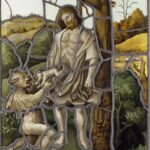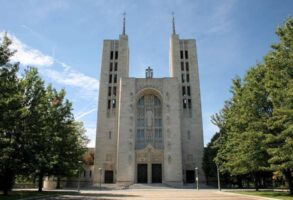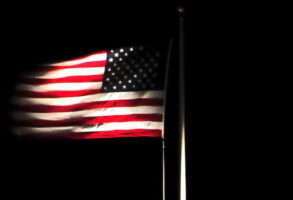
Published November 11, 2020
For someone who was arguably the most prominent Catholic intellectual in the United States in the first half of the 1960s, Father John Courtney Murray, S.J., faded from the scene rapidly after his untimely death in 1967. A new generation of Catholics who imagined that, as one of them once put it, “we know so much more than Murray,” took up one academic fad after another, lowering the intellectual cash value of Catholic thinking about public life in the process. Today, to read back issues of America and Commonweal in the years immediately after Murray’s death is to descend into a realm of the febrile and the fetid: a far cry from the cool and dry atmosphere of public conversation about public goods that Murray championed and embodied.
The forgetting of John Courtney Murray went on for almost twenty years, and I hope I won’t be thought overbearing if I claim to have helped end it. In 1987, I published Tranquillitas Ordinis: The Present Failure and Future Promise of American Catholic Thought on War and Peace, which included a lengthy, pivotal chapter on “The John Courtney Murray Project.” More or less simultaneously, Richard John Neuhaus (to whom I had introduced Murray’s thought) published The Catholic Moment, in which Murray figured prominently. Those who had previously dismissed Murray as impossibly passé now thought they had better try to resurrect Murray for the progressive Catholic project (an intention that Murray would have found risible, if not offensive). So the debate about Murray and his legacy was on, and it hasn’t simmered down since.
Over the course of the debate, at least a few points have been clarified, especially about Father Murray’s influence on the drafting of Dignitatis Humanae, the Second Vatican Council’s Declaration on Religious Freedom. The adoption of Dignitatis Humanae by an overwhelming conciliar majority in 1965 was, in one sense, the crowning moment of Murray’s life; and it must have been immensely satisfying for the man whose Jesuit superiors had banned his publishing on Church-state matters for some years to have concelebrated Mass in St. Peter’s Basilica with Pope Paul VI as an honored peritus (theological adviser) of Vatican II. Dignitatis Humanae was praised in the United States as the American bishops’ principal achievement at the Council, and Murray was regarded as the Declaration’s intellectual father.
In the decades after Vatican II, however, Murray’s role in the shaping of Dignitatis Humanae has come into clearer focus. His articles on the political theory and Church-state theory of Pope Leo XIII certainly played an important role in the 1940s and 1950s in making space for a Catholic development of doctrine on religious freedom. Yet by Murray’s own (subtle) testimony in the immediate aftermath of the Council, the personalist argumentation that undergirded Dignitatis Humanae in its final form was crafted by hands other than his. So it is probably more accurate, now, to think of Murray as the intellectual grandfather (or even great uncle) of Dignitatis Humanae rather than its progenitor.
But if Murray’s role at Vatican II has been clarified, other aspects of his thought and legacy have gotten rather muddled and not infrequently misrepresented.
Thus to some, Murray subordinated Catholic social thought and political theory to John Locke, (mis) understood as the thinker most responsible for an ill-founded American Republic. Others somehow imagine that Murray, allegedly eager to make Catholics “acceptable” in a country long marked by anti-Catholic bigotry, created the conditions for the possibility of pro-abortion Catholic politicians like Ted Kennedy, Robert Drinan, S.J., Barbara Mikulski, Joe Biden, and Nancy Pelosi. Then there is Murray, the putative forerunner of today’s “progressive” Catholicism. Professor Patterson nicely swats down these and other caricatures. At the same time, Patterson lifts up for a new generation the importance of Murray’s retrieval of the “Gelasian Dyarchy” as an antidote to the restorationist fantasies indulged by too many of those who style themselves the “new integralists”: a small cadre promoting what seem to me bad politics and even worse ecclesiology. These debates will doubtless continue. And I hope that, as the sixtieth anniversary of the publication of We Hold These Truths: Catholic Reflections on the American Proposition is marked in 2020, some of the combatants, and especially the Murray-phobes, will actually take the trouble to read Murray carefully, which some seem not to have done.
As one of the agents of the Murray restoration, I find myself less and less interested in these internecine conflicts, though, than in Murray’s continuing salience as a clear-minded thinker about American democracy and its discontents. As those discontents have become ever sharper, to the point where even non-“doomists” must wonder how the American democratic experiment in ordered liberty will renew and revitalize itself, Murray’s warnings from more than a half-century ago, and his analysis of the roots of a possible crack-up of American political culture, strike me as remarkably prescient and well worth pondering today.
The most striking, even ominous, sentences in We Hold These Truths follow immediately after Murray has analyzed the “dissolution” of the original “American consensus,” or public moral culture, under several malign influences: the impact of an Ockhamite theory of freedom-as-willfulness mediated through Benthamite utilitarianism and Jamesian pragmatism; the scientific revolution and the rise of empiricism; and the theological disarray of mainline American Protestantism. That decay in the public moral culture, with its inevitable consequences in political culture and politics itself, was rather far advanced, Murray cautioned. Then came the voice of Murray-the-prophet, who loved what was best in the American experiment but feared that its foundations were crumbling, with potentially grave public results: “Perhaps the dissolution, long since begun, may one day be consummated. Perhaps one day the noble, many-storeyed mansion of democracy will be dismantled, leveled to the dimensions of a flat majoritarianism, which is no mansion but a barn, perhaps even a tool shed in which the weapons of tyranny may be forged.”
Here, in two sentences, is the definitive and, I believe, irrefutable answer to the charge that John Courtney Murray was an uncritical celebrant of the American democratic experiment. To the contrary. Murray knew that the United States was an idea or “proposition” nation: a polity built, not on the old foundations of blood and soil, but on the foundations of a common commitment to certain truths—truths that he, a good natural law man, believed were inscribed into the world and into us; truths that we could know by the exercise of reason; truths that, known, disclosed our duties as individuals and as citizens. But Murray also knew that a nation “so conceived and so dedicated” would not long endure, if the moral and intellectual foundations that make self-governance for the common good possible were to collapse; if the “truths” on which the American democratic experiment relied for its tensile strength were no longer held.
In this analysis, John Courtney Murray, one of my intellectual heroes, anticipated the social doctrine of my other great intellectual model, Pope St. John Paul II. In Centesimus Annus, John Paul’s most developed social encyclical, which was written in 1991 to mark the centenary of modern Catholic social doctrine, the Polish pope wrote of a tripartite “free society” of the future, a society composed of the three interlocking and mutually interactive parts: a democratic polity, a free or market-oriented economy, and a vibrant public moral culture. And in John Paul II’s considered judgment, the public moral culture was the key to all the rest. For absent a vital, culturally transmitted, and socially honored social ethic—a broad-based, culturally-affirmed fealty to the truths about the dignity of the human person and the true meaning of freedom that we can know by reason (or, in vibrantly Judeo-Christian cultures, by revelation as well as reason)—the tremendous human energies set loose by free politics and free economics would be undisciplined, and thus unable to yield either genuine human flourishing or social solidarity. John Courtney Murray would, I suspect, have vigorously agreed.
Interestingly enough, when John Paul II, as a young priest-professor, was leading graduate seminars in philosophy at the Catholic University of Lublin in the late 1950s (the years in which the essays that make up We Hold These Truths were initially drafted), he walked his students through a close reading of the British utilitarian philosopher Jeremy Bentham—who was hardly a prominent figure in Polish intellectual circles of the time. It was as if the two priests, Professor John Courtney Murray of Woodstock Theological College and Professor Karol Wojtyła of Lublin, intuited the same thing, and at just about the same time: while Marxism was a grave threat to the West because its ideas underwrote a grave military threat, the even greater threat over the long haul of history was going to be posed by utilitarianism. It would take another Vatican II peritus, Joseph Ratzinger, to put a label on where utilitarianism (a carrier of metaphysical nihilism, epistemological skepticism, and moral relativism) would lead: to a “dictatorship of relativism” in which coercive state power was deployed to impose a relativistic “ethic” on all of society.
That warning, articulated in 2005, was anticipated by Murray in his 1960 image of the “tool shed in which the weapons of tyranny may be forged,” and by John Paul II’s insistence in Centesimus Annus that democracy and moral truth were intimately related and that that “a democracy without values easily turns into open or thinly disguised totalitarianism.”
So we cannot say, today in 2020, that we were not warned. And one of the first to sound the alarm bell was John Courtney Murray, who knew that the reduction of idea of democracy to a set of functions and institutions would be the death of democracy. Whether Murray’s prescription for American, and indeed western, democratic reform—a recovery of the natural law tradition of moral reasoning as a public grammar for the pluralistic society—can be realized (especially in cultures that have abandoned any notion of givens in human nature) is one of the most urgent questions of our time.
George Weigel is Distinguished Senior Fellow of Washington’s Ethics and Public Policy Center, where he holds the William E. Simon Chair in Catholic Studies. He is the author of twenty-seven books, including his two-volume biography of Pope St. John Paul II, Witness to Hope and The End and the Beginning, and, most recently, The Next Pope: The Office of Peter and a Church in Mission.









